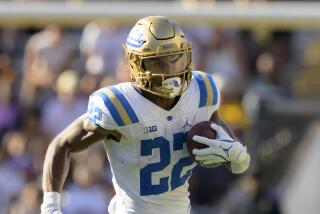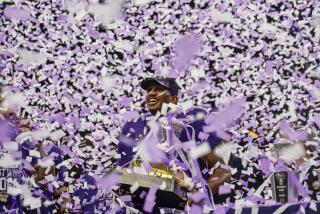UCLA’s Jim Mora has work cut out for him
- Share via
First-week UCLA Coach Jim L. Mora, a former pro defensive specialist, will need time to evaluate opposing Pac-12 Conference offenses.
If he starts now and doesn’t take breaks, he should stumble out of his new office sometime in July. You could have guessed Labor Day had Arizona State hired June Jones.
“I can’t wait to actually sit down and watch film on Oregon,” Mora said after accepting the challenge of becoming UCLA’s next football coach.
The difference between defending offenses in the NFL and the Pac-12 is the difference between a state dinner and potluck. The Pac-12 was junkyard enough, and then Arizona hired Rich Rodriguez and Washington State hired Mike Leach.
Mora, who was introduced during a news conference at UCLA on Tuesday, is an NFL lifer. His college coaching experience is limited to one year, 1984, as a graduate assistant at Washington.
What is Mora walking into? Many UCLA fans are convinced it’s a propeller blade, while UCLA check-signers hope Mora is to Westwood what Pete Carroll was that other team across town.
Carroll, another plucked-from-the-NFL defensive specialist, was criticized as USC’s football hire in 2000 before he ended up 97-19.
Yet, the conference is far more electric and eclectic than the one Carroll came to dominate.
The Pac-10-turned-12 has so many gadgets and gizmos it could be the “Popeil 12.”
In 2001, Carroll’s first year, Oregon won the league with a team that averaged 34.3 points per game. The Oregon team that won this year’s first Pac-12 title averaged 46.2.
Coach Chip Kelly’s spread offense, which has put coordinators on their heels, will be joined by those of spread-masters Leach and Rodriguez.
And that’s not even factoring in Arizona State, still searching for Dennis Erickson’s replacement.
Mora will also see offshoots and hybrids of NFL offenses, each with wrinkles designed to fit the needs of a coach and his recruiting base.
If Mora’s head isn’t yet swimming, well, it’s peering out over a cliff.
“Every defensive guy who comes down from the NFL to college, well, it’s mind-boggling,” said Ed Cunningham, an ESPN college football analyst who played center at Washington and later in the pros. “I played five years in the NFL, switched teams three times, and never had to learn anything.”
Most NFL offenses are cookie-cutter copies of each other, he said, with variations of the same blueprint. College is different because disparity in talent forces offensive coaches to be more creative in order to compete.
The adjustment is significant for NFL coaches. “It’s like showing up at some wild bazaar and you don’t even know what’s for sale,” Cunningham said.
How, for instance, do you begin to explain Oregon?
Kelly’s Ducks averaged 73 plays per game this year while finishing dead last nationally in average time of possession, 25 minutes 3 seconds.
“You see things at Oregon and with some of these teams that you just don’t see in pro football,” Mora said.
That’s why Mora can’t wait to dig in. “I look forward to the challenge, I look forward to the newness of it,” he said.
Oregon’s spread offense is cutting edge, but different than the schemes Leach and Rodriguez will bring to Pullman and Tucson.
“Oregon spreads you to run, which is the most dangerous type of spread,” Cunningham said.
Oregon’s spread seeks to exploit speedy tailbacks LaMichael James, Kenjon Barner and all-purpose freshman De’Anthony Thomas.
Darron Thomas, an able runner at quarterback, has seen his rushing total drop from 486 yards in 2010 to 205 this season. Thomas, though, has passed for 60 touchdowns in two seasons.
Kelly has added a frenetic tempo to his spread that has left audiences, and opposing players, breathless.
Arizona will have a different look under Rodriguez, who will be out to make people forget his 15-22 record at Michigan.
At West Virginia, and earlier as coordinator at Clemson and Tulane, Rodriguez pioneered the “modern spread” and opposing coaches made pilgrimages to Morgantown for insight to his success.
Rodriguez transitioned from a passing spread (with Shaun King at Tulane) to a quarterback-driven offense at West Virginia (Pat White) and Michigan (Denard Robinson).
“You’ve actually seen Rich Rod really morph into what he is now,” Cunningham said.
Leach at Washington State will offer Mora something completely different. His quarterbacks almost never run.
Leach doesn’t care what defense you line up in. His philosophy is to flood your zone or man-to-man with receivers.
“His theory is someone’s open on every play and all you have to do is find them,” Cunningham said.
Leach used his spread at Texas Tech as a talent equalizer in the Big 12. He made stars of passers who would never translate to the pros: Kliff Kingsbury, B.J. Symons, Sonny Cumbie and Graham Harrell.
Leach, at his best, will embarrass your defense the way his team did when it scored 70 on Nebraska in 2004.
The rest of what Mora will see is a hodgepodge.
Theoretically, Mora might have an initial advantage against NFL-rooted offenses like those run by USC, Stanford and Washington. Yet, even those systems are constantly evolving.
USC and Washington, with former USC assistants Lane Kiffin and Steve Sarkisian, are offshoots of Carroll’s pro-style Trojans teams.
Cunningham: “This is more of what Mora was seeing in the NFL.”
USC can run power and play-action and overwhelm teams with superior personnel.
Kiffin, though, is a free-wheeling play-caller who loves to toy with opposing coordinators. His formations on extra-points drive many Trojans fans crazy, but they also force opponents to spend valuable time practicing against it.
California and Coach Jeff Tedford have a more conventional philosophy. Tedford’s teams want to be physical and tenacious. While Tedford is known for developing future Super Bowl winners at quarterback in Trent Dilfer and Aaron Rodgers, his recent teams have produced 1,000-yard tailbacks.
Mike Riley at Oregon State is a hybrid who has blended his NFL background to the recruiting confines of Corvallis. What Riley does best is exploit the talents of his two or three superstar players. He practically invented the “fly sweep” for receiver James Rodgers.
Mora will watch Stanford and think “mystery meat.” The Cardinal runs a pro-style offense feeding off a superstar quarterback and the tough-man persona of former coach Jim Harbaugh.
David Shaw had no reason to change course in his first year, but figuring out what Stanford will be after the departure of Andrew Luck poses another challenge.
“In the NFL if the quarterback leaves you can still put in a tape of last year and get ready to play them the next year,” Cunningham said. “With Stanford, I don’t know that’s the case.”
In preparing for Utah, Mora will confront Norm Chow, one of the most respected offensive coordinators in college football history.
Chow’s strengths are play-calling within the rhythm and flow of a game. Timing and accuracy at quarterback are critical in Chow’s short passing game.
The team Mora has to worry about least, for now, is Colorado, trying to reestablish its identity under second-year Coach Jon Embree.
“One of the things that really gets your juices going is scheming, and trying to come up with something that can beat the guy you’re playing Saturday,” Mora said.
Mora won’t have trouble finding juice in this league. There’s a different fruit on every Pac-12 tree.
More to Read
Go beyond the scoreboard
Get the latest on L.A.'s teams in the daily Sports Report newsletter.
You may occasionally receive promotional content from the Los Angeles Times.











